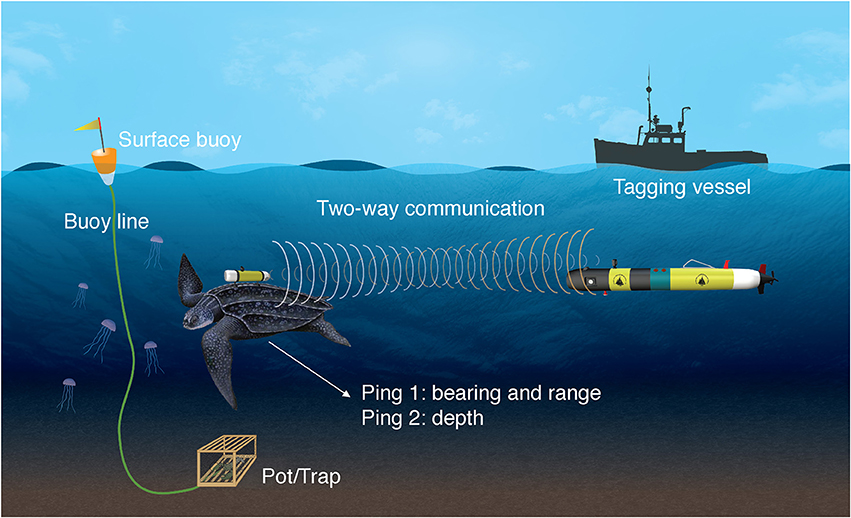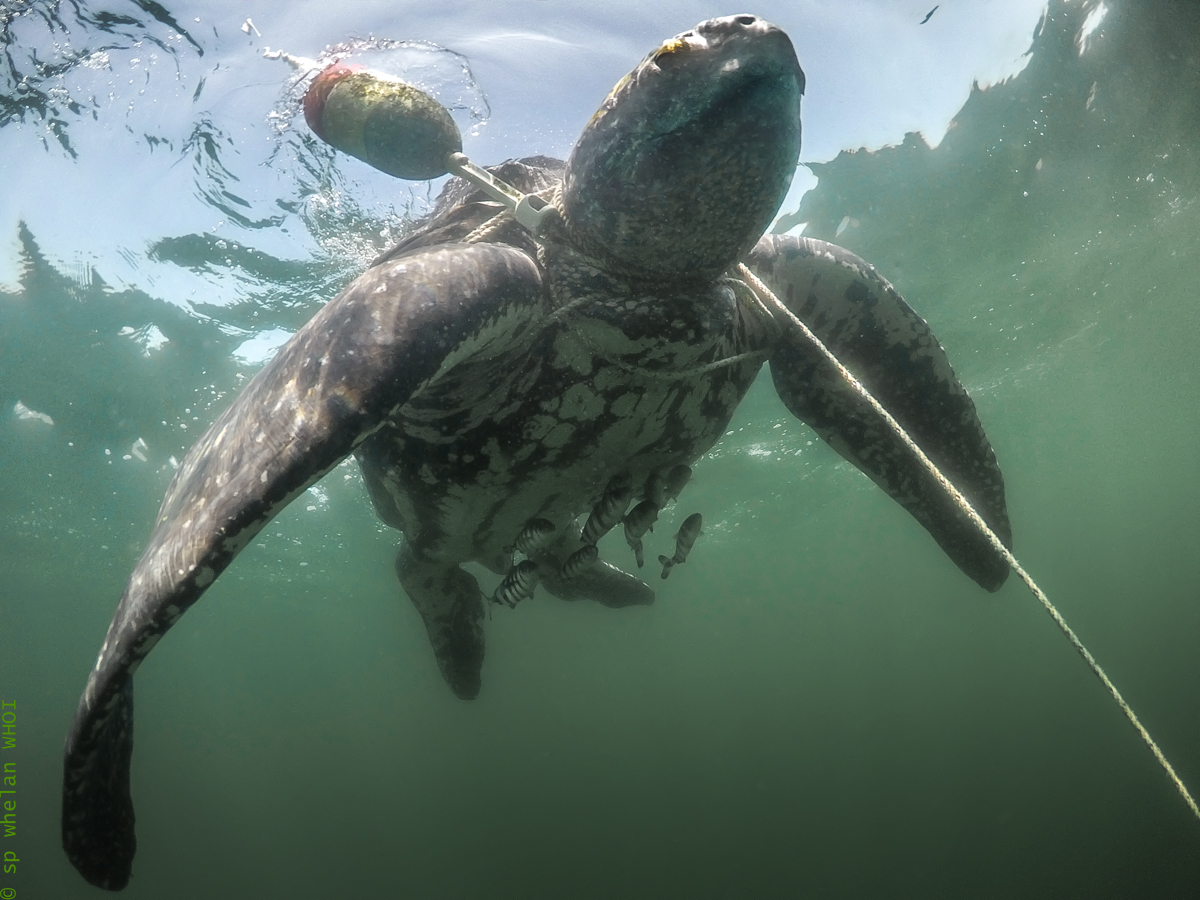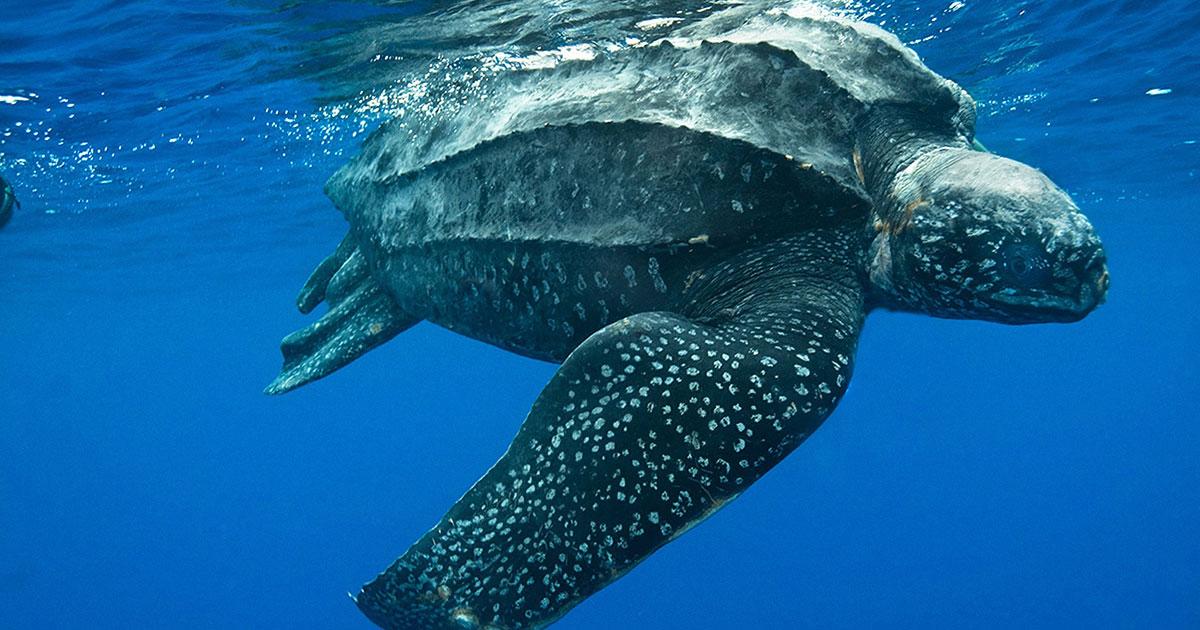The sea turtle has existed for 110 million years—the era of the dinosaurs. The leatherback is the largest species of sea turtle, weighing up to 700 kg and measuring up to 3 meters. It is the only species of sea turtle that does not possess a hard shell and beneath the leathery skin is a medley of bony plates.
In recent years, their urbanized habitats have caused concern for scientists due to the increase in anthropogenic threats along their coastal environment. These creatures regularly encounter pollution, fisheries, and boats that jeopardize their safety.
 A foraging leatherback turtle being tracking by the 'TurtleCam' AUV near fixed fishing gear. The turtle has a suction-cup mounted transponder on its back that communicates acoustically with the AUV. Image courtesy of WHOI.
A foraging leatherback turtle being tracking by the 'TurtleCam' AUV near fixed fishing gear. The turtle has a suction-cup mounted transponder on its back that communicates acoustically with the AUV. Image courtesy of WHOI.
Progressions in autonomous underwater vehicle (AUVs) technology have allowed researchers to directly observe the fine-scale subsurface behaviors and habitat choices of marine megafauna. A new pilot study conducted in the high-risk coastal environment off Cape Cod, Massachusetts, utilized a REMUS-100 AUV connected to six video cameras devised as ‘TurtleCAM,’ to locate, follow and film tagged leatherback turtles. An animal-borne transponder with cameras was used to understand and record the turtle’s behavioral viewpoint. Environmental data was also gathered along the turtle’s track.
 Leatherback turtle entangled in the buoy line of pot gear off Cape Cod, Massachusetts. Photo credit: Sean P. Whelan/WHOI
Leatherback turtle entangled in the buoy line of pot gear off Cape Cod, Massachusetts. Photo credit: Sean P. Whelan/WHOI
Researchers documented the results for one leatherback turtle during the pilot study. The individual spent 15% of its time at the surface and approximately 30% within the top 2 meters of the water column, placing the turtle inside the striking range of a vessel’s hull or propeller. This data shows that leatherbacks are highly prone to vessel-induced mortalities. Furthermore, results demonstrated that leatherbacks utilized the entirety of the water column in this particular study area. Interestingly, the individual revealed prey-silhouetting behavior to capture jellyfish, which could be linked to entanglement risk.
“Our findings have direct implications for conservation and management of leatherback turtles off Massachusetts and in regions with similar bio-physical oceanographic conditions,” explained lead author Kara Lodge from Woods Hole Oceanographic Institution.
The success of ‘TurtleCam’ has provided researchers with a unique platform to track and image subsurface habitats and behaviors of mobile species. In an environment where endangered species coincide with anthropogenic threats, it is vital to design and implement efficient and successful mitigation strategies in the future.
Reference: Dodge, K. L., Kukulya, A.L., Burke, E., & Baumgartner. (2018). TurtleCam: A ‘Smart’ Autonomous Underwater Vehicle for Investigating Behaviours and Habitats of Sea Turtles. Frontiers in Marine Science, 5:90.
By Margaux Monfared, Institute of Marine Sciences, University of Portsmouth, UK.





